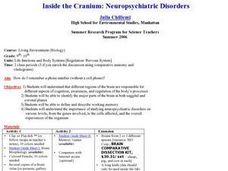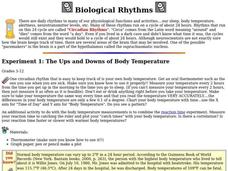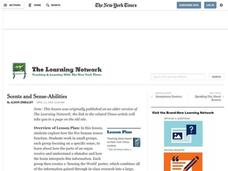Curated OER
It's All in Your Mind
Pupils investigate the definition of memory. In this memory lesson students investigate strategies to improve memory as well as examine what the difference is between a short-term memory and a long-term memory.
Curated OER
Integrating Biology-Muscles and Work
In this muscle and work worksheet, students read about aerobic, anaerobic and resistance exercise. They apply what they read and answer three questions about these three types of exercise.
Curated OER
Mapping the Homunculus
Students determine the relative number of nerve endings located in the skin. By calculating the reciprocal of these measurements, students have the appropriate data for predicting the relative size of the homunculus found on the cerebral...
Curated OER
Inside the Cranium: Neuropsychiatric Disorders
Students analyze different regions of the brain which are responsible for different aspects of cognition, awareness and regulating the body's process.
PBS
Stories of Painkiller Addiction: Contemplating Nature vs. Nurture
Does having an addict in your family make it more likely to become one yourself? Explore the genetic risk factors, as well as the prominent environmental influences, for substance addiction in a lesson that encourages awareness and open...
Curated OER
Review for Strand 2A Test: Nervous System
Three pages containing 51 true and false questions make up this nervous system review. The major topics listed at the top of the test mention a film strip and a laboratory activity, but the questions appear to be answerable without...
Curated OER
Biological Rhythms
Students conduct experiments to determine their circadian rhythms for a cycle of about 24 hours.
University of Minnesota
What's the Deal? Addiction Card Game
Addiction is a big deal! Playing a game of cards helps learners understand the concept of addiction. Through their analysis, they examine the potential for addiction and how it varies for each individual.
Curated OER
Bones: Reading and Quiz
Make no bones about it- this anatomy activity is all about the human skeleton! Learners read a 2-page informational excerpt on bones and then use the information they learned to answer 9 recall questions, including 4 multiple-choice and...
Curated OER
Photosynthesis and Respiration
Eighth graders differentiate photosynthesis and respiration. In this biology lesson, 8th graders draw a diagram explaining these two processes. They answer a quiz after the lesson.
Curated OER
Nervous System Introductory Worksheet
In this nervous system worksheet, students answer thirty short answer questions about the structures and functions of the nervous system and its subsystems.
Curated OER
Drugs Change the Way Neurons Communicate
High schoolers examine that certain drugs interfere selectively with neurotransmission, and realize that the effect of a drug is dependent upon dosage and route of administration.
Curated OER
In Their Own Words
Students watch a video of people telling about their experiences with a mental illness. They compare and contrast the life stories they saw to reinforce how mental illnesses are biological illnesses that affect a person's thoughts,...
Curated OER
Scents And Sense-Abilities
Students explore how the five human senses function. They work in small groups, each group focusing on a specific sense. Each group then creates a 'Sensing the World' poster which combines all of the information gained through in-class...
Curated OER
What is the Anatomy of the Visual System?
Students research the structures and functions of the eye. In small groups they dissect a model of the human eye, identify structures of the eye, and describe the functions of the photoreceptors.
Curated OER
Apoptosis: Programmed Cell Death During Development
Students model the plasticity of neural pathways for memory in the brain. They simulate the cell activity according to dots on cards that they are given. They complete various simulations of different cell combinations.
Curated OER
Protection, Support, and Locomotion
In this skeletal system worksheet, students will read a graphic organizer and complete 1 short answer question about the five functions of the skeleton. Then students will use a graphic organizer about muscle types to fill in a table...
Curated OER
Protection, Support, and Locomotion
In this vertebrate skeleton worksheet, middle schoolers will read a paragraph about the function of bones, muscles, and skin. Then students will complete 6 short answer questions.
Curated OER
Neuron Creations
Students examine neurons. In this nervous system lesson, students build models of neurons in order to study their parts and functions.
Curated OER
Show 303: New Research into Dyslexia
Students explore the causes of dyslexia. They view CT sans and MRIs to view the brain and how it responds. Students read reports about dyslexia. They discuss the nature of dyslexia, its cause, how to diagnose it, and its permanency.
Curated OER
What Does Your "Homunculus" Look Like?
Students determine the density of touch receptors in various parts of the body on the right hand side. They use collected data to draw a picture of the
"homunculus" of an experimental subject.
Curated OER
The Real Bionic Man
Pupils examine the work that scientists have been doing to create artificial human parts. In this exploratory lesson plan students research the human eye and brain using the Internet.
Curated OER
Levels of Organization
Students brainstorm a list of all the functions organisms carry out and how they carry them out. In groups, they are given the smallest and highest level of organization in organisms and are to fill in the missing spaces. To end the...
Curated OER
Human Body Systems: The Domino Effect
Students create a domino course to represent different human body systems. They discover the systems relationship to each other and their functions. They answer questions to complete the lesson.























